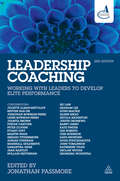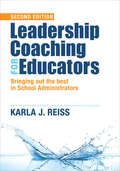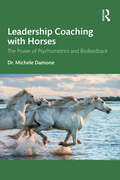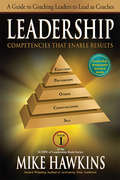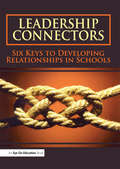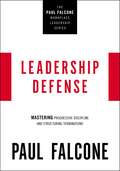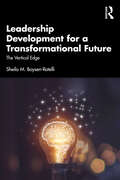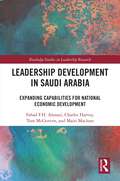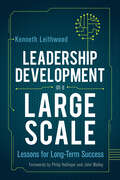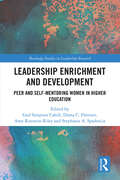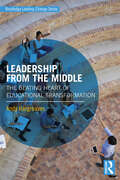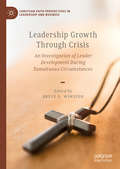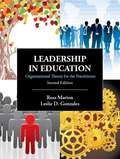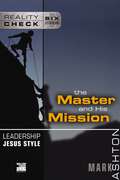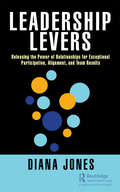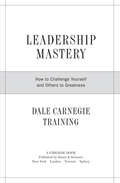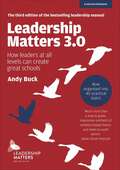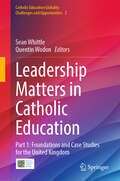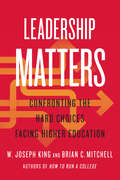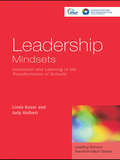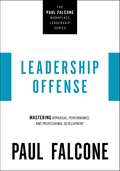- Table View
- List View
Leadership Coaching
by Jonathan Passmore Association for CoachingThis revised edition of the highly-respected Leadership Coaching will enhance and extend your coaching practice. It draws on evidence-based thinking and the writing of some of the world's top leadership thinkers and coaching practitioners to present a start-of-the-art coverage of leadership models and how to use them effectively to benefit your coaching relationships. Leaders face many challenges, and this book will challenge you to adapt your coaching approach to suit your clients' needs. Its coverage ranges from newer topics such as strengths focused leadership and conversational leadership to more tried-and-tested frameworks such as Porter's strategy model and Goleman's model of leadership styles. It also has a deliberately international flavour, incorporating non-Western perspectives from Asia and Africa and considering multinational topics like coaching global boards.
Leadership Coaching for Educators: Bringing Out the Best in School Administrators
by Karla ReissEmpower your staff through coaching! There is an urgent need for school leaders to go beyond "top-down" supervision and coach educators to succeed. Use this comprehensive resource to design and implement an effective, school-wide coaching system that yields powerful results. Aligned with the International Coach Federation’s Professional Coaching Core Competencies, this revised edition demystifies the coaching process and includes: Recent research projects, award-winning success stories, and trends in the field Guidance for school leaders on developing, designing, and implementing a successful coaching program Graphic organizers and practical examples of coaching dialogue Evaluation tools for coach development An expert educational consultant and founder of The Change Place, LLC, the author is a former president of the New York State Staff Development Council. "Leadership Coaching for Educators offers coaching tips and examples that can be easily adapted. A major strength of this book is the focus on a current topic. The author provides the background, definitions, a foundation and steps necessary for successful coaching implementation." —Delsia Easley, Principal W. E. Striplin Elementary Gadsden, AL "The work is very well organized and is presented sequentially. It is very easy to follow. The author makes a great case that a major part of the success of each player is dependent upon the coach and the coaching process." —Dr. Robert A. Frick, Superintendent (Retired) Lampeter-Strasburg School District "The author’s passion for coaching is evident. This makes the text more engaging and helps the reader to become more curious about exploring coaching a change strategy." —Ruth S. Johnson, Professor of Educational Leadership California State University, LA
Leadership Coaching for Educators: Bringing Out the Best in School Administrators
by Karla ReissEmpower your staff through coaching! There is an urgent need for school leaders to go beyond "top-down" supervision and coach educators to succeed. Use this comprehensive resource to design and implement an effective, school-wide coaching system that yields powerful results. Aligned with the International Coach Federation’s Professional Coaching Core Competencies, this revised edition demystifies the coaching process and includes: Recent research projects, award-winning success stories, and trends in the field Guidance for school leaders on developing, designing, and implementing a successful coaching program Graphic organizers and practical examples of coaching dialogue Evaluation tools for coach development An expert educational consultant and founder of The Change Place, LLC, the author is a former president of the New York State Staff Development Council. "Leadership Coaching for Educators offers coaching tips and examples that can be easily adapted. A major strength of this book is the focus on a current topic. The author provides the background, definitions, a foundation and steps necessary for successful coaching implementation." —Delsia Easley, Principal W. E. Striplin Elementary Gadsden, AL "The work is very well organized and is presented sequentially. It is very easy to follow. The author makes a great case that a major part of the success of each player is dependent upon the coach and the coaching process." —Dr. Robert A. Frick, Superintendent (Retired) Lampeter-Strasburg School District "The author’s passion for coaching is evident. This makes the text more engaging and helps the reader to become more curious about exploring coaching a change strategy." —Ruth S. Johnson, Professor of Educational Leadership California State University, LA
Leadership Coaching with Horses: The Power of Psychometrics and Biofeedback
by Michele DamoneLeadership Coaching with Horses offers a transformative approach to leadership development, combining the intuitive power of equine-assisted learning with the precision of biometric technology and psychometric profiling.This book introduces a pioneering method that harnesses the unique sensitivities of horses alongside advanced biofeedback mechanisms like heart-rate variability (HRV), providing a comprehensive pathway to enhance personal and professional growth. Delving into the synergistic relationship between humans and horses, this guide details how such interactions foster heightened self-awareness and emotional intelligence. It presents a structured framework for leadership sessions that merge feedback from horses with robust data from biometric and psychometric assessments, enabling a detailed exploration of leadership traits and behaviours and offering measurable outcomes for development.Distinguished by its novel integration of biometrics and psychometrics into leadership coaching with horses, this book is designed to deepen understanding and enable leaders to make real-time, impactful enhancements to their leadership styles. With practical applications, case studies, and a clear articulation of benefits, it is an essential resource for coaches, HR professionals, and leaders seeking innovative, evidence-based tools for advancement.
Leadership Competencies that Enable Results: A Guide To Coaching Leaders To Lead As Coaches (book 1 Scope Of Leadership) (SCOPE of Leadership Book Series #1)
by Mike HawkinsFirst in the “most comprehensive treatment of leadership I’ve ever seen by one author . . . full of insightful assessments, useful tools, and practical tips” (Jim Kouzes, coauthor of The Leadership Challenge).Leadership Competencies That Enable Results explores the essentials of great leadership and establishes the principles that underpin the ability to coach, lead, and achieve high levels of organizational performance. Laying the groundwork for the competencies introduced over the course of the series, this book guides you in building a leadership roadmap for yourself and others to follow on the journey to enabling great results.The SCOPE of Leadership book series teaches the principles of a coaching approach to leadership and how to achieve exceptional results by working through people. You will learn a straightforward framework to guide you in developing, enabling, exhorting, inspiring, managing, and assimilating people. Benefit from the wisdom of many years of leadership, consulting, and executive coaching experience. Discover how to develop the competencies that align consistently with great leadership.“Hawkins clearly and succinctly presents the difference between being a manager and a true leader . . . Anyone who wants to be a modern-day effective leader will have much to gain by reading this first book in the SCOPE of Leadership Book Series.” —Foreword Reviews
Leadership Connectors: Six Keys to Developing Relationship in Schools
by La Vern Burmeister Phyllis HensleyThis book will help you connect with your faculty and staff and develop the relationships necessary for student success. With practical examples and specific strategies, it will help you thrive as an effective school leader. It will help you communicate better, bring out the best in your staff, and build strong relationships in your schools.
Leadership Defense: Mastering Progressive Discipline and Structuring Terminations (The Paul Falcone Workplace Leadership Series)
by Paul FalconeGreatly reduce the stress of managing a team with this quick and reliable information on how to correctly master—both legally and ethically—progressive discipline and structured termination, from the leading voice in HR expertise.This resource takes the highly complicated subjects of progressive employee discipline and structured terminations—actions that can be rife with legal issues and paperwork—and breaks down the process for HR professionals and managers to easy-to-understand steps.Chock full of wisdom from Paul Falcone, a renowned expert on labor & employment law and business decision-making and problem-solving, this book answers questions ranging from basic to sophisticated, including:Why should I conduct an exit interview?How do I protect my company from negligent hiring claims?How do I terminate a long-term employee with a history of positive performance evaluations?And much, much more.Each question is followed by an easy-to-implement solution, making this book perfect both as a concise overview and as a practical reference.
Leadership Development for a Transformational Future: The Vertical Edge
by Sheila M. Boysen-RotelliAn essential resource for leaders seeking to thrive in ambiguity, this book explores the pressing need for vertical leadership development in a world defined by rapid change, digital revolution, and complexity.Traditional horizontal leadership development focuses on skills but falls short in helping leaders navigate complexity, ambiguity, and exponential technological advances. What’s needed now is vertical development that emphasizes expanding leaders' capacity to think strategically, manage complexity, and lead with empathy. This book bridges the gap between traditional leadership development and modern demands by providing practical tools for vertical development and, uniquely, integrating digital coaching platforms. Backed by case studies and insights from global leaders who have successfully applied vertical development, it offers actionable frameworks and strategies and introduces AI-driven coaching solutions to enhance leadership growth.Ideal for senior executives, leadership coaches, HR professionals, organizational consultants, and postgraduate leadership students, this book will help readers cultivate the mindset and skills necessary to succeed in a complex and rapidly changing world.
Leadership Development in Saudi Arabia: Expanding Capabilities for National Economic Development (Routledge Studies in Leadership Research)
by Charles Harvey Mairi Maclean Fahad F.H. Alanazi Tom McGovernLeadership Development in Saudi Arabia offers a comprehensive examination of the role of leadership development in expanding capabilities for national economic development, accelerating realization of the ambitious goals of Vision 2030, the country’s blueprint for socioeconomic transformation.Based on nine case studies of leading Saudi companies, this book explores how and why firms invest in leadership development and assesses its current state in Saudi Arabia. It provides insights into both organizational talent-building and the country's journey toward economic diversification. The book stands out as one of the first contextually rich in-depth studies of leadership development in a non-Western context, particularly within the ambitious framework of Saudi Arabia’s Vision 2030. Through interviews with senior executives and leadership professionals, the book provides actionable recommendations for improving leadership development practices.Readers will benefit from detailed case studies and empirical data that highlight how leadership programs can drive business growth and national economic progress. It is essential reading for academics, leadership development professionals, policymakers, and business leaders interested in understanding how leadership development supports economic growth in Saudi Arabia and how it might play an even bigger role in the future. It proposes developing fresh approaches to widening the pool of leadership talent, building on the distinctive strengths of Islamic Leadership practices.
Leadership Development on a Large Scale: Lessons for Long-Term Success
by Kenneth LeithwoodIt considers how to make effective use of good evidence to build, refine and adapt leadership development initiatives so they contribute to growth in powerful forms of leadership and those conditions in schools that matter most to students.
Leadership Development on a Large Scale: Lessons for Long-Term Success
by Kenneth LeithwoodIt considers how to make effective use of good evidence to build, refine and adapt leadership development initiatives so they contribute to growth in powerful forms of leadership and those conditions in schools that matter most to students.
Leadership Education 100: Traditions, Wellness, and Foundations of Citizenship
by The Editors at the PearsonThis book is the first component of Junior Reserve Officers Training Corps (JROTC) leadership education. It is intended for students who are entering the JROTC program and beginning their high school studies.
Leadership Enrichment and Development: Peer and Self-Mentoring Women in Higher Education (Routledge Studies in Leadership Research)
by Stephanie A. Spadorcia Gail Simpson Cahill Diana C. Direiter Amy Rutstein-RileyThis book shares the LEAD (Leadership Enrichment and Development) method, a framework for supporting and facilitating leadership identity development for women in higher education. Guided by feminist group processes and relational learning, the chapters in this volume illustrate the impacts of self- and peer mentorship on the authors. Part lived experience, part reflection on scholarship on women’s leadership development, this book has implications for those in leadership development settings across professional sectors and career trajectories, offering strategies, implications, and insights for those developing or seeking to learn about peer mentoring programming for women faculty. Women faculty, leadership development coaches, faculty development leaders, directors of centers for teaching excellence, program leaders focused on girls’ and women’s leader development, and students and scholars interested in women’s leadership development in higher education will find this volume of interest. While LEAD’s context is higher education, the volume offers valuable application to other professional settings where women work, lead, and thrive.
Leadership From the Middle: The Beating Heart of Educational Transformation (Routledge Leading Change Series)
by Andy HargreavesIn the face of a global pandemic, catastrophic weather events, war, racism, and attacks on democracy, how should educational leaders respond? How can leaders enable their schools and districts to be agile, safe, and effective places of learning that help young people develop the knowledge and character that will empower them to shape their futures? While some schools and districts have taken top-down or bottom-up approaches, renowned education scholar Andy Hargreaves explores a new type of leadership – "leadership from the middle" – which becomes a driver of transformational change. Drawing from research with educational leaders across the United States, United Kingdom, and Canada, Hargreaves discusses a type of leadership that regards obstacles as opportunities, embraces leadership paradox, and is collaborative, inspiring, and inclusive. This ground-breaking book unpacks not only what this type of leadership looks like, but also how it is most effective in addressing complex problems and in educating young people to develop diverse global competencies to prepare them for their futures.
Leadership Growth Through Crisis: An Investigation of Leader Development During Tumultuous Circumstances (Christian Faith Perspectives in Leadership and Business)
by Bruce E. WinstonThis edited collection uses a biblical lens to explore how to lead effectively and grow in a crisis situation. The chapters examine topics such as communicating through crisis, developing organizations and leaders through crisis, personal crisis and leadership development, and ethics and morality in crisis. Case studies include David's response to Goliath's challenge, Joseph's leadership and management of Egypt, and the team leadership and resilience of Esther and Mordecai in navigating a possible Jewish genocide.This book makes a unique contribution to the crisis leadership literature by examining the topic from a Christian perspective and will foster future research into the role of spirituality in organizational crisis.
Leadership In Education: Organizational Theory For The Practitioner
by Russ Marion Leslie D. GonzalesLeadership in Education: Organizational Theory for the Practitioner
Leadership Jesus Style: The Master and His Mission (Reality Check)
by Mark AshtonThe Reality Check series makes just one assumption: that you’re serious enough about your spiritual journey to investigate Christianity with an open mind. This isn’t about joining anyone’s religious club—it’s about being real with yourself and with the others in your group. Since no one has all the answers, there’s plenty of room for discussion. After all, if there is any truth to the Bible’s stories about Jesus, then one thing he’d welcome are questions and opinions that come from honest, earnest hearts.Whether you’re leading a corporation, a sports team, your family, or simply your own pursuits, issues such as mission, character, vision casting, and team building are critical to your success. Wouldn’t it be great to take lessons from a master leader? Here’s your opportunity. Nobody in history has surpassed Jesus of Nazareth in either methods or results. Find out his leadership secrets. They’re guaranteed to make you a better leader.Leadership Jesus Style includes these sessions: Upside-Down Leadership What’s Your Mission? Casting a Vision The Master Strategist Building a Team When Others FailFor the Group LeaderReality Check is for spiritual seekers of every persuasion. Uncompromisingly Christian in its perspective, it steers wide of pat answers and aims at honesty. This innovative and thought-provoking series will challenge you and those in your group to connect heart to heart as together you explore the interface between Jesus, the Bible, and the realities of this world in which we live.
Leadership Levers: Releasing the Power of Relationships for Exceptional Participation, Alignment, and Team Results
by Diana JonesThere’s an epidemic of leadership failure—whether something as small as a meeting, or as large as implementing enterprise wide change. Leaders know that sinking feeling when a gap emerges between themselves and the groups they most need to engage with. Leaders and business schools are looking in the wrong places for the cause. What holds most leaders back, as if their foot is always on the brake, is their failure to engage, and gain alignment. This book shows the reasons why. Leaders rarely recognise that: Shaping group behavior is describable as a process, which they can learn. Instead, they unconsciously fall into relationship patterns influenced by early family experiences. Informal relationship patterns have a dramatic effect on results, which is why birds in flight manage to alter course without bumping into each other. Leadership and collaboration are primarily a matter of principles and process, and not personality and content alone. If leaders master the process, they achieve consistent results. This book reveals the leadership levers to release the power of relationships for exceptional participation, alignment and results in organizations. It enables leaders to mine the brilliance that often lies dormant and untapped within their organizations. Readers will have the principles and tools to go beyond the agenda, truly engage with those around them, and release untapped capacities within their organizations. These qualities and skills will inspire associates and employees.
Leadership Mastery
by Dale Carnegie TrainingIn a world becoming more and more virtual, human relations skills are being lost -- along with the skill of leadership. And yet never before have these abilities been more valuable or sought after. What's needed is a new type of leader -- one who can inspire and motivate others while adhering to timeless leadership principles such as flexibility, adaptability, trustworthiness, and distribution of power. With Leadership Mastery, you will identify your strengths and adopt effective strategies to: Gain the respect and admiration of others using little-known secrets of America's most successful leaders Get family, friends, and coworkers to do what you ask because they want to, not because they have to Respond effectively in a crisis Make powerful decisions and follow through on them using Carnegie's action formula Incorporating interviews with top leaders in business, entertainment, sports, and academia, Leadership Mastery stands next to the classic How to Win Friends and Influence People.
Leadership Matters 3.0: How Leaders At All Levels Can Create Great Schools
by Andy BuckFULLY REVISED AND UPDATED! This book is just one element of a suite of resources designed to help improve the educational outcomes for all children by empowering educational leaders in national, regional and local contexts to examine, refine and develop their leadership skills.In this revised and updated edition, the author takes an in-depth and diagnostic approach, encouraging leaders at all levels in schools to think about their own personal qualities; their specific situation; their own leadership actions; and their own overall leadership approach.Developed alongside the book, the Leadership Matters website gives school leaders affordable access to high quality online diagnostic tools, videos and other leadership resources. Everything on the website, including the 40 exclusive videos, is designed around the same 40 topics from the book (known as the LM40), making it really easy for busy school leaders to find what they need.
Leadership Matters 3.0: How Leaders At All Levels Can Create Great Schools
by Andy BuckFULLY REVISED AND UPDATED! This book is just one element of a suite of resources designed to help improve the educational outcomes for all children by empowering educational leaders in national, regional and local contexts to examine, refine and develop their leadership skills.In this revised and updated edition, the author takes an in-depth and diagnostic approach, encouraging leaders at all levels in schools to think about their own personal qualities; their specific situation; their own leadership actions; and their own overall leadership approach.Developed alongside the book, the Leadership Matters website gives school leaders affordable access to high quality online diagnostic tools, videos and other leadership resources. Everything on the website, including the 40 exclusive videos, is designed around the same 40 topics from the book (known as the LM40), making it really easy for busy school leaders to find what they need.
Leadership Matters in Catholic Education: Part 1: Foundations and Case Studies for the United Kingdom (Catholic Education Globally: Challenges and Opportunities #2)
by Quentin Wodon Sean WhittleThis edited collection is the first part of a two-volume set., which focuses on leadership in Catholic education settings in the United Kingdom. It includes an overview of the importance of different types of leadership, including ‘servant-leadership’, in understanding and framing Catholic school practice, a critical survey of why leadership matters to ensuring the success of Catholic education, and a discussion of what counts as the defining characteristics of leadership in Catholic education and how this relates to the aims or philosophy of Catholic education. The chapters in this book draw from the insights and experiences of serving Catholic school leaders as well as from academics and researchers in Catholic education studies. The final two chapters provide a comparative analysis for the United Kingdom in a global perspective using data from the Organisation for Economic Co-operation and Development (OECD) . Together, the chapters argue that there is an urgent need to find, nurture, and sustain outstanding leaders for Catholic schools and colleges.
Leadership Matters: Confronting the Hard Choices Facing Higher Education
by Brian C. Mitchell W. Joseph KingLeadership matters more than ever in this turbulent moment in American higher education.During these unprecedented times, glaring internal inefficiencies, communication breakdowns, and an overriding sense of cultural inertia on many campuses are too often set against a backdrop of changing consumer preferences, high sticker prices, declining demand, massive tuition discounting, aging infrastructure, technological and pedagogical alternatives, and political pressure. Strategic leadership in such a complex environment needs to be exercised in nuanced ways that differ from those embraced by corporate cultures. In Leadership Matters, W. Joseph King and Brian C. Mitchell argue that the success of higher education institutions depends on strategic leaders who can utilize the strengths of their institutions and leaders to balance internal pressures, shifting demographics, global education needs, and workforce preparation demands beyond the college gates. Drawing on their extensive experience, the authors guide senior administration, trustees, and presidents on how to lead during immense financial, demographic, and social challenges. King and Mitchell believe that, to survive, colleges must be well run—flexible, effective, and forward thinking. The authors begin with a fundamental premise—that colleges and universities must evolve and adapt by modernizing their practices, monetizing their assets, focusing on core educational strategies, and linking explicitly to the modern world. Discussing a broad range of leadership positions, including presidents, provosts, and board chairs, Leadership Matters touches on strategic planning, management and operations, stakeholder relations, campus and community, accreditation and athletic conferences, and much more. The authors offer an optimistic assessment based upon frank and stark conclusions about what colleges must do—and must not do—to remain relevant in the coming decades.
Leadership Mindsets: Innovation and Learning in the Transformation of Schools (Leading School Transformation)
by Linda Kaser Judy HalbertThe evidence is clear - school leaders make a difference to the learning of the pupils they serve. And yet, not all leaders have the same degree of impact. What are the factors that make the difference to student learning? Why are some leaders able to raise student achievement in schools in the most challenging circumstances whilst other leaders struggle to simply maintain the status quo? Drawing from international case study research over many years, from the experience of hundreds of school leaders serving widely diverse communities, Judy Halbert and Linda Kaser argue that there are six distinct mindsets that characterize the way successful, learning-oriented leaders operate and make sense of their professional world. These leaders are: motivated by intense moral purpose knowledgeable about current models of learning consistently inquiry-oriented able to build trusting relationships evidence-informed able to move to wise action. This book outlines an alternative way of thinking about school leadership. It examines research evidence that leaders will find most useful and suggests how they might use this evidence to maximise their learning and the learning of their students. Leadership Mindsets has been written specifically for aspiring to newly-appointed school leaders who are determined and motivated to create quality and equality for learners in the schools they serve, through networks of inquiry, learning and support.
Leadership Offense: Mastering Appraisal, Performance, and Professional Development (The Paul Falcone Workplace Leadership Series)
by Paul FalconeReady-to-use words, phrases, descriptions, and action items right at your fingertips to organize and streamline employee reviews, create clear and effective career development plans, and monitor performance year-round, from the leading voice in HR expertise.Whether you're an HR professional or a manager, turn to this great tool for scripts and templates you can apply immediately to your employee reviews.Chock full of wisdom from Paul Falcone, a renowned expert on appraisal, motivation, and professional and career development, this book:Provides sample phrasing for key performance areas to drastically reduce the time it takes to complete multiple employee reviews.Offers language to use for both positive and negative evaluations that offer concrete and constructive feedback.Includes many examples of behaviors, strengths, and opportunities to document when writing any type of evaluation or performance appraisal.Mid-year, end-of-year, and all appraisals in between, this handy, easy-reference resource helps turn a task many managers dislike and avoid—giving performance reviews—into a much more succinct, positive opportunity that puts your employees on the path to success.
